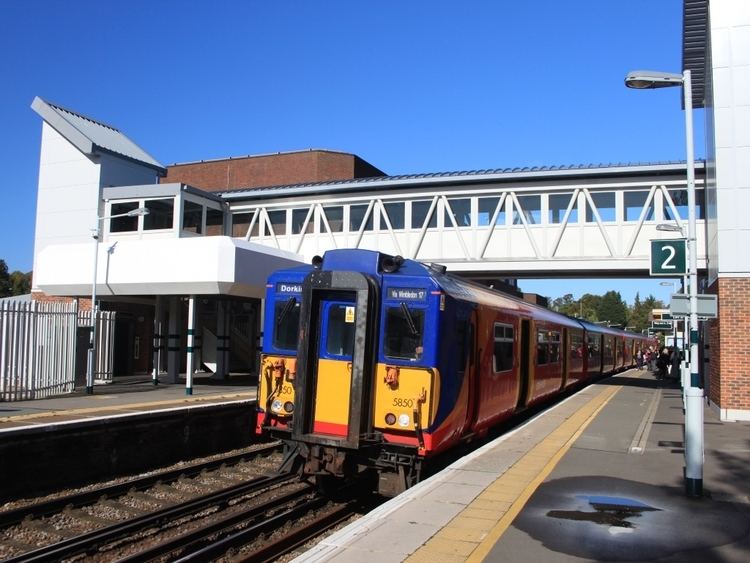Station code DKG Number of platforms 3 | Grid reference TQ170504 | |
 | ||
Local authority | ||
Dorking railway station is one of three railway stations that serve the town of Dorking in Surrey, England. The station is within walking distance of Dorking Deepdene station and interchange on a through ticket is permitted. Dorking West and Dorking (Deepdene) are on the North Downs Line.
Contents
There are two trains per hour towards London Waterloo, two towards London Victoria and an hourly service to Horsham (Monday to Saturday off-peak). South West Trains services to London Waterloo typically use Platform 2. Southern services to Horsham generally depart from platform 3.
The station, previously called Dorking North, was rebuilt in the 1980s and is now part of the office block which houses the headquarters of Biwater.
Ticket barriers were installed in 2010.
Construction
The Mole Gap between Dorking and Leatherhead is one of the few natural breaches in the North Downs and its potential as a rail corridor was realised as early as 1830 when a line linking London to Brighton was proposed. In 1845-6, the "Direct London and Portsmouth Railway" was authorised by parliament to run south from Epsom to Dorking on to Godalming, Havant and Portsmouth. The scheme failed to attract sufficient investment and was dropped in favour of the Woking, Guildford and Havant route from London Waterloo.
The first railway line to link Dorking with London was the independently promoted "Reading, Guildford and Reigate Railway" proposed in 1845-6, authorised by Acts of Parliament in 1846 and 1847. This became the line we know today as the North Downs Line.
By 1859 the LBSCR and LSWR had built a joint line to Leatherhead from Epsom where their tracks separated (the former heading for London Bridge the latter for London Waterloo. An independent Horsham, Dorking and Leatherhead Railway was set up and promoted by interested local parties (principally from Horsham) to link the three towns. The railway was approved by Act of Parliament in July 1862, but only from a junction with the North Downs Line, 100 yards (91 m) to the east of Dorking Deepdene, to the Arun Valley Line at Horsham.
A year later in July 1863 LBSCR secured authority to build the line from its station at Leatherhead to make a connection with the line from Horsham. The line to Leatherhead was opened on 11 March 1867, however the connection with the line from Horsham was not made until 1 May 1867. Initially services ran from London Bridge to Brighton via Sutton and Steyning four times per day in each direction.
Electrification
The Southern Railway, formed in 1923, began an extensive programme of electrification of their suburban lines. The line from Waterloo to Dorking was electrified using the 660V third rail system in 1925 and regular half-hourly semi-fast services were introduced on 12 July 1925 to run seven days per week. The 22.5 mi (36.2 km) journey to Waterloo originally took 45 minutes, although this was considerably lengthened when trains began to stop at all stations shortly afterwards. An additional hourly electric service to London Bridge via Mitcham Junction and Tulse Hill began on 3 March 1929; the 25 mi (40 km) journey took 53 minutes.
The mid-Sussex electrification of 1938 resulted in the express steam services from Portsmouth and Bognor Regis being replaced by electric services which were routed through Dorking, calling at Sutton and Victoria only. These gave commuters from Dorking their fastest ever link to Victoria (34 minutes during peak hours). In the timetable change of May 1978 the mid-Sussex express services were routed via Gatwick Airport and the off-peak service to Dorking was reduced to two semi-fast services from Victoria per hour, with services to Horsham running every two hours. Now the average journey time to London termini takes a passenger 55 minutes.
The service to Horsham was neglected for some years during the 1980s with a shuttle service between Dorking and Horsham operating every two hours at off peak times. The service now provided is one train an hour through from London to Horsham, (headcode 84). The off peak service of two trains from London Bridge to Horsham via Sutton and Dorking ran for a number of years from about 1985 but had ceased by 2000. The former Horsham to Waterloo via Dorking North trains (headcode 15) ceased as early as 1980.
Signal box
The resignalling scheme of 1938 introduced three aspect colour signals to replace the original semaphore signals. A new signal box was constructed and opened on 15 May 1938. It is one of many built in the Odeon style by the Southern Railway during the 1930s. The original frame was an A2 type Westinghouse with 44 levers. The box controls the line from Box Hill & Westhumble to Warnham.
Typical journey times
In common with the 16 hourly off-peak closer commuter services to/from London Waterloo calling at Earlsfield railway station and all local London stations all managed by South West Trains, trains must stop at every intermediate station. There are no fast services available to mid distance destinations, which gives overcapacity towards the suburban terminus (Dorking) due to the longer journey time and overcrowding during the inner city phase of journeys. This situation can be contrasted to certain other routes to destinations just outside Greater London in certain other directions. <ref>e.g. New Southern Railway's Tonbridge, Reigate and East Grinstead services which until leaving London only call at Clapham Junction and at East Croydon.</ref
